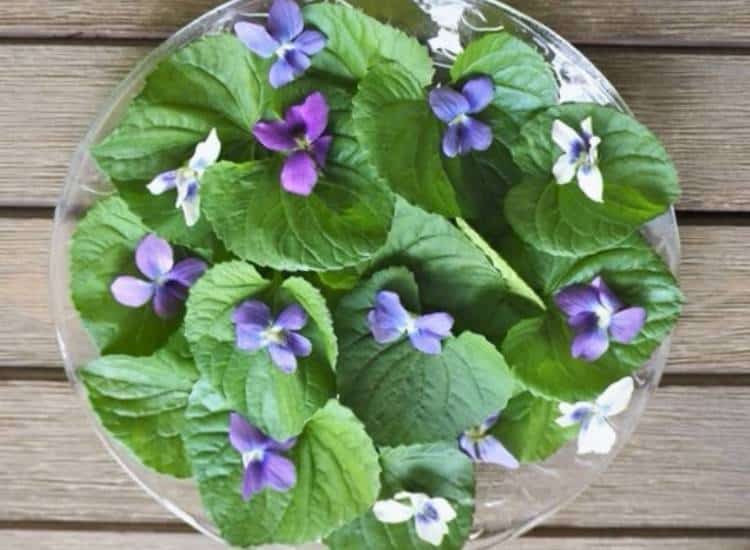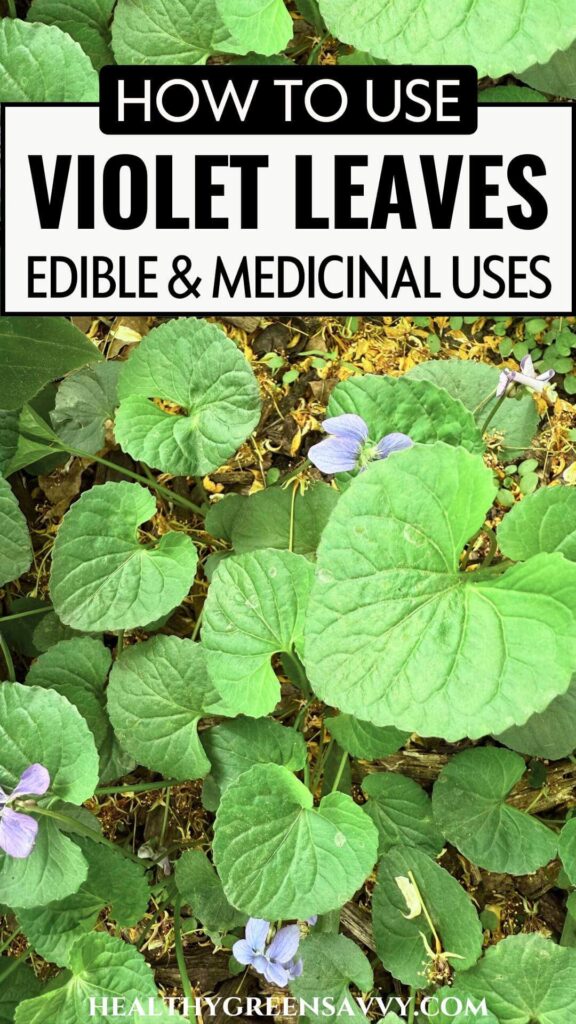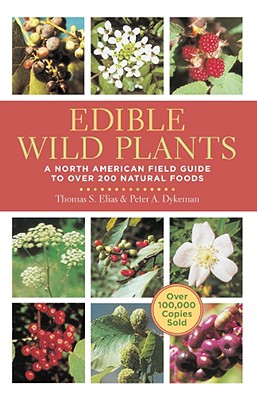Last Updated on May 17, 2025
Did you know that common wild violet leaves are edible and medicinal? Beautiful violet flowers are around just a few weeks, but violet leaves can be harvested all season. Read on to discover the many uses for violet leaf in the kitchen and home apothecary, and you’ll enjoy foraging this abundant and useful wild plant.

Discover the Many Uses for Violet Leaf
While wild violets’ lovely spring blossoms get a good deal of attention each spring, wild violets’ leaves deserve some notice as well.
I’ve covered uses for wild violets in a separate post, and even collected 25 wild violet recipes you can explore. But over the years I’ve become more and more enamored with violet leaf and wanted to give them their own write-up.
As the trees we planted in our front yard grew, we had more and more shade. Wild violets loved these conditions, and they soon took over, creating an attractive green carpet in our front yard.
Wild violets make an excellent herbal ground cover, one of several grass alternatives to explore if you’re looking for something to replace a lawn, an eco-friendly landscaping move that will save you time, energy and money.
I love our violets’ pretty edible flowers, and I often use them with a smattering of leaves in springtime salads, but when I learned about the medicinal benefits of the leaves, they became violets’ main attraction for me. Because they’re around so much longer than the flowers, we have many more opportunities to use them for food and medicine.
Violet leaves have helpful medicinal properties that I take advantage of all season long, and then I dry plenty of violet leaf to see me through the winter.
Are Violet Leaves Edible?

They are indeed! Violet leaves are not only edible, they’re quite mild and pleasant-tasting, especially when they’re young. Unlike many wild greens, they don’t have the bitter flavor some foragers find offputting.
Violet leaves are also nutritious. They’re reportedly a very good source of vitamins A and C, as well as fiber and antioxidants. Herbalists value them especially for their mucilage, which can make them a little ‘slimy’ when cooked, but also makes them soothing for digestion and medicinally useful for things like coughs and sore throats.
Older leaves will be tougher and are better used medicinally than as food. Some violets may have more saponins in the leaves that will affect their flavor and can cause nausea, so check the flavor of your leaves before consuming them in quantity.
The violets you’ll most often find in North America are Viola sororia, often called common blue violet or wood violet. You may also find sweet violets (Viola odorata) or white-flowered Canada violet (Viola canadensis.
Sam Thayer writes in his outstanding Field Guide to Edible Wild Plants that Canada violets are his favorite, particularly the tender leaves, which he says have “an exotic hint of wintergreen.”
Check out other recommendations for the best foraging books.
Foraging Wild Violet Leaf

Whenever you forage, you need to be sure you have the right plant. Consult a reputable field guide (like those above) and check multiple features of the plant.
Wild violets are low-growing perennials with leaves that are typically heart-shaped with scalloped edges. They usually have fine hairs on both sides of the leaf, but they can be smooth.
Flowers have five petals, usually in shades of purple, though they can also be white or yellow.
Violet leaves grow from the base in a clumping habit and often form dense ground cover. They grow in a variety of habitats, from deep shade to full sun. You’ll find them often growing in lawns and gardens, as well as along forest edges.
This post has good descriptions of lookalikes that could be confused with violets, especially when they’re not flowering.
Always consult a good field guide to ensure your plant identification is correct. I highly recommend taking a foraging class in your community, or check out Herbal Academy’s online foraging course.
Always avoid foraging from areas sprayed with pesticides or near roadsides where contamination is likely.
Because wild violets grow readily and often spread in lawns and shady gardens, violet leaves are often fine to harvest in quantity. But you should always harvest responsibly, making sure to leave plenty to help the plant continue to thrive. Note that many species of violet are threatened or endangered in certain areas. You can run a search under “threatened species + [your state]” to find a list published by the state or local Department of Natural Resources.
If you fall in love with violet leaves, you might consider encouraging them in your own garden. They tolerate shade well, require little care, and can be used for both food and medicine. And those pretty little flowers are such a welcome sight in spring!
Uses for Violet Leaves in the Kitchen
Interested in cooking with violet leaf? Here are some ideas:
- Add violet leaves to salads: Young violet leaves are tender and mild, and can be mixed with other spring greens.
- Blend in smoothies: Add some extra nutrition by blending a handful of violet leaves with your favorite fruits and yogurt.
- Use as a soup thickener: Thanks to their mucilage, violet leaves can help thicken soups and stews.
- Mix into pesto: Combine violet leaves with other wild greens like chickweed or dandelion for a foraged spring pesto.
- Use as a cooking green: If you cook with violet leaves, be forewarned that their mucilage content — which makes them good thickeners and accounts for some of their medicinal value — can make them somewhat slimy, which not everyone enjoys.
Medicinal Uses for Violet Leaves
Violet leaves have been used traditionally for a wide range of ailments. Their cooling, moistening properties make them a go-to for coughs and sore throats.
Soothing sore throats and coughs: As a tea, or syrup, violet leaves can soothe irritated tissues in the throat.
Skin care: The anti-inflammatory properties of violet leaves make them beneficial in salves and poultices for dry skin, eczema, insect bites, and minor wounds. The Nerdy Farm Wife explains how to use them in salves, soaps, and more.
For moving lymph: Herbalists use violet leaf both internally and externally to support the lymphatic system, important for removing waste and supporting the immune system.
Pain relief: Matthew Alfs reports that violets contain salicylic acid, which explains their traditional use as a pain reliever. A compress of violets is sometimes used as a remedy for headaches. Violets are also considered anti-inflammatory.
Sleep support: Violets reportedly have relaxing properties and are sometime recommended as a sleep aid. Some research is investigating violets’ efficacy as a remedy for insomnia.
Poultice for pain relief and healing: A useful plant to know for outdoor first-aid, violet leaves may be mashed or chewed and used as a poultice.
Rico Cech also reports using tea or tincture to topically to resolve rashes, hives, and cradle cap.
You can find more about the medicinal uses of wild violets at Herbal Academy.
Always consult a knowledgeable herbalist or healthcare provider before using wild plants medicinally, especially if you’re pregnant, nursing, or on medication.
Violet Leaf Tea

One of the simplest ways to use violet leaves is to make tea. You can use fresh or dried violet leaf. Tea made with fresh leaves has a strong chlorophyll flavor that may not be the tastiest. Dried leaves have a more mild, green flavor.
Violet leaf tea can be made on its own or incorporated with other herbs, which might be preferable if you’re using fresh leaves. Because they may have a soporific and pain-relieving effect, I usually throw some violet leaves in with other herbs for sleep when I make a batch of my go-to nighttime tea.
Violet leaf tea can help soothe coughs and sore throats, so drying some leaves for winter use means you can have a helpful medicinal ingredient on hand when it’s most needed.
Here’s a simple wild violet tea recipe.
Harvesting & Preserving Violet Leaves
Violet leaves can be harvested throughout the growing season, but they’re most tender and tasty in early spring.
I highly recommend preserving plenty of violet leaf for later use. They come in handy in winter, when you use them in teas or syrups to soothe coughs and sore throats.
I have one of these collapsible drying screens and fill it with leaves and herbs foraged from my yard all season long.
To preserve violet leaves:
- Dry them: Spread the leaves in a single layer on a screen or drying rack in a warm, well-ventilated area out of direct sunlight. Store in an airtight jar once fully dried.
- Make a tincture. Check out our tutorial for wild violet tincture.
- Freeze them: Blanch leaves briefly in boiling water, then cool, pat dry, and freeze in small portions for later use.
- Infuse in oil: For skin applications, infuse dried violet leaves in a carrier oil to use in salves or massage blends. Here’s how to infuse herbs in oil from the Herbal Academy.
Whether you toss them into a salad, brew a healing tea, or make a soothing skin salve, violet leaves make a wonderful addition to your cooking and herbal remedy toolkit.
Have you used violet leaves before? Leave a comment and share how you like to use them!
Do you love seeking out nutritious and medicinal plants? Be sure to explore other wonderful wild herbs:
Save this info on using violet leaf for later!


Susannah is a proud garden geek and energy nerd who loves healthy food and natural remedies. Her work has appeared in Mother Earth Living, Ensia, Northern Gardener, Sierra, and on numerous websites. Her first book, Everything Elderberry, released in September 2020 and has been a #1 new release in holistic medicine, naturopathy, herb gardening, and other categories. Find out more and grab your copy here.





 Hi, I'm Susannah, a garden geek, energy nerd, and fan of healthy food and natural remedies. Need some simple, practical solutions for living healthier and greener? You've come to the right place! More about me and my green projects
Hi, I'm Susannah, a garden geek, energy nerd, and fan of healthy food and natural remedies. Need some simple, practical solutions for living healthier and greener? You've come to the right place! More about me and my green projects
Leave a Reply